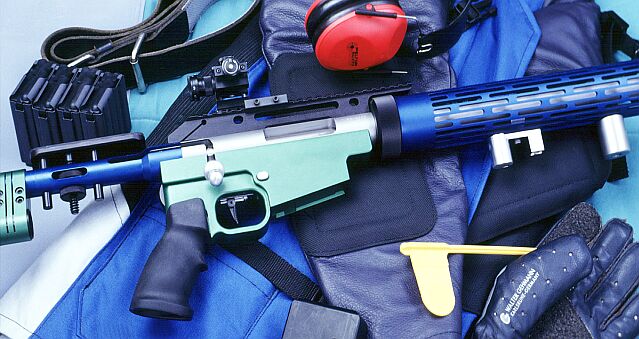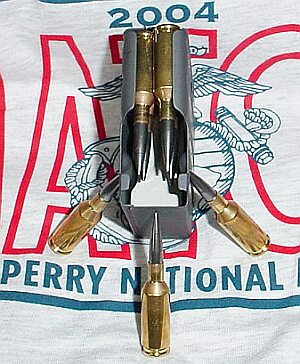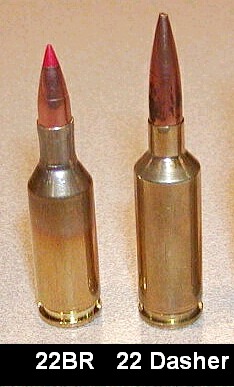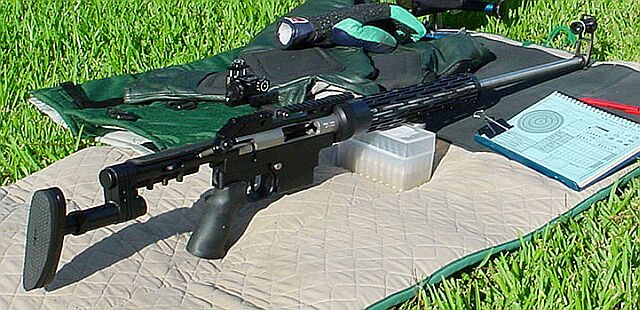|
Fast-Twist T2K in 22BR
Versatile Platform to Shoot the New 90-Grainers
Other Guns of the Week >
The 22BR cartridge is viewed by many as primarily a varmint round. However, with the new high-BC bullets, it offers excellent long-range performance. With the recent introduction of the new 90gr Sierra Match-Kings, we expect to see a lot more interest in the 22BR in a variety of shooting disciplines. Here we feature the Tubb 2000 rifle of Clint Greenwood. Clint did his load testing with the 90gr JLK (Jimmy Knox) VLDs, but now the new Sierras promise to rival the performance of the JLKs with readily-available factory bullets. That's good news for long-range shooters since we're told Jimmy is retiring from the bullet-making business.

Copyright © 2004, Glen Zediker, David Tubb, and SSS Inc., used with permission. Rifle showing anodized finish color options.
A 'New Twist' on the Tubb 2000
Some months ago, Texan Clint Greenwood let us know about a 22BR project he had in the works. We were intrigued by the potential of 90gr bullets in this cartridge. Clint reports: "I got involved with the 22BR after working with its parent case, the 6mm BR Norma. I became interested in the 6BR about three years ago. I had read everything I could find concerning the 6BR, particularly several of Larry Bartholome's Precision Shooting articles. I was convinced that I just had to have a 6BR, so I took a Rem 700 short action that I had and sent it off to Greg Tannel for some work. While waiting for the rifle to return, I succumbed to the fever and purchased a Tubb 2000, also in 6BR. Both of these rifles were outstanding. It was harder to find a load that didn't work in the 6BR than to find one that did.
I devote most of my shooting time to High Power XC, but shoot the occasional prone match. My home club was constructing a 1000-yard range and would shortly begin shooting monthly 1000 prone matches. I had originally planned to shoot one of my 6BRs in the prone matches, but a friend that I shoot with, also a 6BR fan, had recently built a bolt-gun in 22BR, and was really pleased with it. We talked at length about his rifle. He had Dave Kiff grind a reamer that would allow him to neck down Lapua 6BR brass to 22 BR and not have to neck turn. His rifle was barreled with a 7.7-twist Kreiger, and he was having great success shooting the 80 Sierra MK across the course.
 Better BC for Service Rifle Competition Better BC for Service Rifle Competition
I am primarily a Service Rifle shooter, shooting an AR. Being aware of the self-imposed limitations of shooting the AR Service Rifle, particularly at long range, I had always endeavored to gain every advantage for myself. When the .224 90gr Jimmy Knox (JLK) VLDs came out about four years ago, I jumped on the bandwagon with a passion. I was easily able to obtain 2750 FPS with the 90 out of the tiny .223 case using VV N540, moly and CCI 450 primers. This familiarity with the quirks of the 90 JLK led me to build my wife a prone rifle in .223. I had John Holliger chamber a 30" PacNor in 1:6.5" twist for the rifle. John Holliger is absolutely the guru for 6.5-twist barrels, having pioneered them. I have had a half-dozen 6.5-twist PacNors that John has done, and every one has been a hummer. Using the 30" barrel, I was able to push the 90gr JLK to 2900 FPS with no problems. The 90gr's BC has been listed from .560 to .590, and pushing it at 2900 fps, it was obvious that, as far as a .22 was concerned, the 90 JLK was the best wind-bucking bullet out there. [Editor's Note: Sierra's published BC for the new 90gr SMK is .504 (above 2200 fps). So the JLK enjoys a distinct BC advantage--if you can get your hands on them.]
Several factors converged at once to finally turn on the dim 10-watt bulb in my head. I had a large supply of Lapua 6BR brass, several thousand 90gr JLKs, a friend with a 22BR reamer for loan, and a gunsmith that really knew his way around 6.5 twist PacNor barrels who also made T2K barrels. I was doomed! Holliger chambered a 30" 6.5-twist PacNor for my T2K, using my friend's reamer. I was busy getting tooling ready. When the barrel arrived, I removed the 6BR barrel off of my T2K, and screwed the 22BR barrel on.
 Brass-Forming -- Run-out Problems Emerge Brass-Forming -- Run-out Problems Emerge
Necking the brass down presented several problems right away. The perfect Lapua brass came out of the Redding FL 22BR die sporting .010" runout. It was obvious that going from .243 to .224 was creating the runout, but there wasn't a lot I could do about it. I went ahead and cleaned up the necks with my K&M neck turner, taking a decent cut on the shoulder, as it was obvious I was creating a doughnut during the necking down. I ran the turned brass back through the sizer die, with no expander, and then inside neck reamed with a .221 reamer. I used a mandrel to expand the necks, using two different mandrels to obtain some cases with .004 and some with .002 neck tension.
I talked with Wes Grass, who had been playing with the 22BR and the 90 JLK. He opined that Varget, while a stellar powder in the 6BR, was simply too fast for the 22BR pushing the 90-grainer. Wes suggested trying VV N550, of which I had a supply. I loaded incremental loads of 0.5 grain of Varget and N550, in the two different sets of neck-tensioned cases. Being familiar with the 6BR, and having spoken with Wes about his loads, I began the Varget loads at 30.0 going up to 32.0. The N550 started at 30.0 also, and went up to 31.5. The following is a table of what I worked up using the 90gr JLK:
| VARGET Charge | Velocity | Extreme Spread | Std. Dev. | | 30.5 | 3022 | 14.3 | 6.2 | | 31.0 | 3091 | 28 | 11.5 | | 32.0 Ejector marks -- too hot | 3185 | 2.5 | 2.2 | | Vihtavuori N550 Charge | Velocity | Extreme Spread | Std. Dev. | | 30.0 | 2861 | 60.9 | 27 | | 30.5 | 2930 | 46 | 16.5 | | 31.0 | 2960 | 33 | 12.7 | | 31.3 -- Match Load | 3050 | 22 | 9 | | 31.5 | 3062 | 10.5 | 4.9 |
All of the above loads used Lapua 6BR brass, neck turned and reamed, .004 tension, CCI BR4 primers. (I did settle on .003 neck tension). These loads were OK in my rifle. Reduce at least 10% before using them! [EDITOR'S NOTE: If you start about 10% under these loads, that shoould be a good beginning point for using the new 90gr Sierra Match-King in a 22BR.]

Final Thoughts on Bullets, Powder and the 22BR
After almost four years of experience with the 90gr JLK, a few observations are in order. First, as a general rule, these true VLD bullets DO NOT LIKE TO JUMP! I load almost all of my 90s, be it in .223 or 22BR, with at least .030" engagement into the lands. Yes, I know very well that John Scandale won the Porter Trophy (AR15 Service Rifle at 1000 yards), at Camp Perry in 2003 shooting bare 90s with RL-15 and jumping them, but that is an anomaly that has not been repeated.
Second, do not be disappointed with the 500 series VV powder as you work up loads. Until you reach a certain point in load density and pressure, accuracy will just plain suck. At some point, when the planets get aligned and the world is right, and the pressure curve is kosher, the groups will suddenly shrink dramatically. The 500 series of VV powders are only efficient and accurate at peak pressures. When you reach the operating pressure for the 500 series of powder, groups shrink dramatically, as if a light switch has been thrown.
Working up the loads for the 22BR didn't yield any surprises with the components that I had chosen. At 30.5 grs, the VV N550 loads began to really group into knotholes. 31.5 grains of N550 yielded some pretty impressive groups, as well as chrono numbers that were encouraging. I decided to back off 0.2 grains, as shooting in South Texas, I might be shooting these loads anywhere from 45 degrees to 110 degrees. The VV 500 series is fairly temperature insensitive, not as good as Varget, but decent, but on a few occasions in the past I have had a few "pressure excursions" that were unsettling in .223, and didn't want to go there with my T2K. Dropping the loads 0.2 grains didn't appear to change the accuracy and gave me a little insurance. At 200 yards, the warmer N550 loads were consistently under 1/2 MOA. I expect a bit better results when I use the fireformed brass, instead of the new Lapua that was sporting .010" runout.
I am really pleased with the accuracy of my T2K in 22BR. I have to give most of the credit to John Holliger. If he hadn't gone out on a limb and experimented with the PacNor 6.5 twist .22 barrel, none of this would have been possible. Good Luck, and remember to work up to these loads!"
-- Clint Greenwood --
David Tubb Explains T2K Stock Adjustments
I advocate setting stock length a little longer than most people might. I am a firm believer that it is best to "reach" slightly for the pistol grip as this ensures a strong, secure hold on the rifle. I pull the rifle firmly into my shoulder pocket when shooting offhand, and also prefer to have what I would characterize as very firm contact between rifle butt and shoulder in the sitting and prone positions as well. When using a sling in prone or sitting, stock length (and sling tension) should be great enough so that, at the least, you have to push the buttpad forward with your hand in order to place the stock into the shoulder pocket. My buttstock is shortest offhand and longest prone. If my standing setting is "0", I'm usually out about 1-1/2 inches for sitting and about another inch for prone. I have found that many people tend to shoot with a stock that's too long in sitting and too short everywhere else.
I have found the cast off/on adjustment feature on the buttstock to be of great help to me in attaining the natural shooting positions I desire. For prone, I offset the clamping block so the buttplate moves outward [the index mark on the clamp is to the right of center on the scale on the receiver extension tube]. I swing it a little bit inward for offhand and slightly more inward for sitting. The amounts of cast on/off (in clock-face terms) are approximately 6:30 for standing, 4:30 for prone, and 8:00 o'clock for sitting.
Stock Position Diagrams Copyright © 2004, Glen Zediker, David Tubb, and Superior Shooting Systems Inc., used with permission.
Stock Length Adjustment Procedure
The buttstock is adjustable in length 4-plus inches. This adjustment is accomplished by moving the buttplate tube in or out after loosening the four screws on the clamping block. Ensure that the buttstock tube is fully contained in the block. The extent of rearward (lengthening) movement is determined by the front of the buttstock tube fitting flush with the front of the block.
Cast and Cant Adjustment Procedure
The buttstock is adjustable for cast or offset by loosening the four screws on the clamping block and swiveling the block on the receiver extension tube. The buttplate itself is adjustable for cant up to 360 degrees and after loosening the screw directly in the center of the rubber recoil pad is adjustable for height at approximately 1-1/2 inches. The cheekpiece is adjustable vertically approximately one inch. The vertical cheekpiece adjustment is accomplished via the top knurled ring. The lower knurled ring will then secure the setting. |
For more information on the Tubb 2000 Rifle and SSS Accessories, contact:
Superior Shooting Systems
Maker of Tubb 2000 Accessories,
and DTAC Bullets and Brass
DavidTubb.com
Phone: (806) 323-9488
FAX: 806-323-9483 | Creedmoor Sports
Tubb 2000 Rifles and Barrels
CreedMoorSports.com
1405 So. Coast Highway
Oceanside, CA 92054
Phone: 1-800-CREEDMOOR (273-3366) or (760) 757-5529 |
Top Photo, home page photo and Stock Position Diagrams ALL Copyright © 2004, Glen Zediker, David Tubb, and Superior Shooting Systems Inc., used with permission, All Rights Reserved. Other content Copyright © 2005, 6mmBR.com, All Rights Reserved. No reproduction without advanced permission in writing.


|